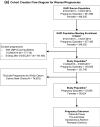Development and Validation of ICD-10-CM-based Algorithms for Date of Last Menstrual Period, Pregnancy Outcomes, and Infant Outcomes
- PMID: 36656445
- PMCID: PMC9981491
- DOI: 10.1007/s40264-022-01261-5
Development and Validation of ICD-10-CM-based Algorithms for Date of Last Menstrual Period, Pregnancy Outcomes, and Infant Outcomes
Erratum in
-
Correction to: Development and Validation of ICD‑10‑CM‑based Algorithms for Date of Last Menstrual Period, Pregnancy Outcomes, and Infant Outcomes.Drug Saf. 2023 May;46(5):515. doi: 10.1007/s40264-023-01280-w. Drug Saf. 2023. PMID: 36964331 Free PMC article. No abstract available.
Abstract
Introduction and objective: Validation studies of algorithms for pregnancy outcomes based on International Classification of Diseases, 10th Revision, Clinical Modification (ICD-10-CM) codes are important for conducting drug safety research using administrative claims databases. To facilitate the conduct of pregnancy safety studies, this exploratory study aimed to develop and validate ICD-10-CM-based claims algorithms for date of last menstrual period (LMP) and pregnancy outcomes using medical records.
Methods: Using a mother-infant-linked claims database, the study included women with a pregnancy between 2016-2017 and their infants. Claims-based algorithms for LMP date utilized codes for gestational age (Z3A codes). The primary outcomes were major congenital malformations (MCMs) and spontaneous abortion; additional secondary outcomes were also evaluated. Each pregnancy outcome was identified using a claims-based simple algorithm, defined as presence of ≥ 1 claim for the outcome. Positive predictive values (PPV) and 95% confidence intervals (CI) were calculated.
Results: Overall, 586 medical records were sought and 365 (62.3%) were adjudicated, including 125 records each for MCMs and spontaneous abortion. Last menstrual period date was validated among maternal charts procured for pregnancy outcomes and fewer charts were adjudicated for the secondary outcomes. The median difference in days between LMP date based on Z3A codes and adjudicated LMP date was 4.0 (interquartile range: 2.0-10.0). The PPV of the simple algorithm for spontaneous abortion was 84.7% (95% CI 78.3, 91.2). The PPV for the MCM algorithm was < 70%. The algorithms for the secondary outcomes pre-eclampsia, premature delivery, and low birthweight performed well, with PPVs > 70%.
Conclusions: The ICD-10-CM claims-based algorithm for spontaneous abortion performed well and may be used in pregnancy studies. Further algorithm refinement for MCMs is needed. The algorithms for LMP date and the secondary outcomes would benefit from additional validation in a larger sample.
© 2023. The Author(s), under exclusive licence to Springer Nature Switzerland AG.
Conflict of interest statement
AKC, MCD, JFC, JDS are employees of Optum and may own stock in UnitedHealth Group. KP and CE were employees of Optum. SEC, BHM, and MCS are employees of and may own stock/stock options in AbbVie, Inc.
Figures


Similar articles
-
Identification of pregnancies and their outcomes in healthcare claims data, 2008-2019: An algorithm.PLoS One. 2023 Apr 24;18(4):e0284893. doi: 10.1371/journal.pone.0284893. eCollection 2023. PLoS One. 2023. PMID: 37093890 Free PMC article.
-
Validation of an ICD-10-based algorithm to identify stillbirth in the Sentinel System.Pharmacoepidemiol Drug Saf. 2021 Sep;30(9):1175-1183. doi: 10.1002/pds.5300. Epub 2021 Jun 11. Pharmacoepidemiol Drug Saf. 2021. PMID: 34089206
-
Identification of pregnancies and infants within a US commercial healthcare administrative claims database.Pharmacoepidemiol Drug Saf. 2022 Aug;31(8):863-874. doi: 10.1002/pds.5483. Epub 2022 Jun 7. Pharmacoepidemiol Drug Saf. 2022. PMID: 35622900 Free PMC article.
-
Development and Validation of Claims-Based Definitions to Identify Incident and Prevalent Inflammatory Bowel Disease in Administrative Healthcare Databases.Inflamm Bowel Dis. 2023 Dec 5;29(12):1993-1996. doi: 10.1093/ibd/izad053. Inflamm Bowel Dis. 2023. PMID: 37043675 Free PMC article. Review.
-
Diagnostic Algorithms for Cardiovascular Death in Administrative Claims Databases: A Systematic Review.Drug Saf. 2019 Apr;42(4):515-527. doi: 10.1007/s40264-018-0754-z. Drug Saf. 2019. PMID: 30471046
Cited by
-
Health Service Use and Costs During Pregnancy Among Privately Insured Individuals With Congenital Heart Disease.JAMA Netw Open. 2024 May 1;7(5):e2410763. doi: 10.1001/jamanetworkopen.2024.10763. JAMA Netw Open. 2024. PMID: 38739390 Free PMC article.
-
Discover overlooked complications after preeclampsia from three real-world medical record datasets of over 100,000 pregnancies.medRxiv [Preprint]. 2024 Nov 2:2023.12.05.23299296. doi: 10.1101/2023.12.05.23299296. medRxiv. 2024. PMID: 38405849 Free PMC article. Preprint.
-
Systematic Review of Avian Influenza Virus Infection and Outcomes during Pregnancy.Emerg Infect Dis. 2025 Jan;31(1):50-56. doi: 10.3201/eid3101.241343. Epub 2024 Dec 12. Emerg Infect Dis. 2025. PMID: 39668388 Free PMC article.
-
Systematic review of validated case definitions to identify hypertensive disorders of pregnancy in administrative healthcare databases.Open Heart. 2023 Aug;10(2):e002151. doi: 10.1136/openhrt-2022-002151. Open Heart. 2023. PMID: 37567603 Free PMC article.
-
Maternal influenza vaccination and associated risk of fetal loss: A claims-based prospective cohort study.Vaccine. 2024 Dec 2;42(26):126256. doi: 10.1016/j.vaccine.2024.126256. Epub 2024 Sep 10. Vaccine. 2024. PMID: 39260053 Free PMC article.
References
-
- Phiri K, Clifford RC, Gately RV, Doherty MC, Seeger JD. Development of a dynamic pregnancy database within the Optum Research Database. 2018:210-211.
Publication types
MeSH terms
LinkOut - more resources
Full Text Sources
Medical

